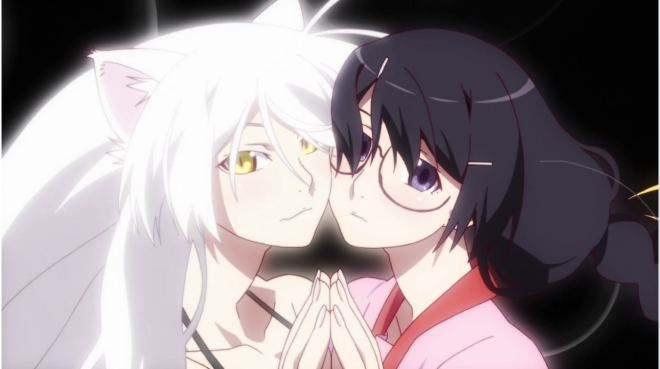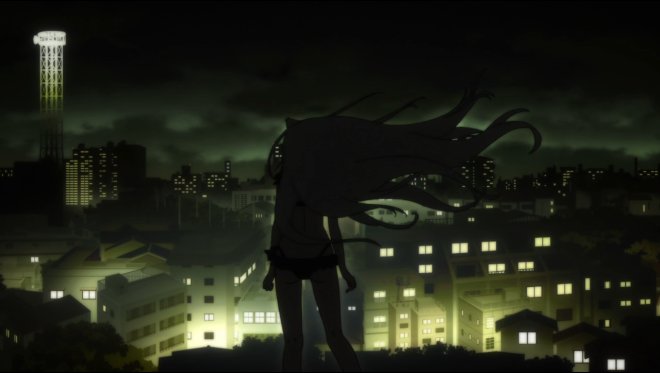Koyomi Araragi (阿良々木 暦 Araragi Koyomi?)
Voiced by: Hiroshi Kamiya[1]
Koyomi, the main character of the story, is a third year high school student who is close to failing every subject except math. Shortly before the first novel begins, he was attacked by a vampire during spring break and became a vampire himself. Although Meme Oshino helped him become human again, there are several lingering side effects: he can see in the dark, his eyes turn red when he gets angry, and he heals incredibly quickly. As a result he has concerns regarding his lifespan. These side effects are later revealed to be due to the bond that Shinobu and he share. He remains scared of morning sunlight despite the fact that it no longer has any negative effects on him. He started dating Hitagi at the end of Mayoi Snail.
Although he is shown to be attracted to the other girls, he turns their advances down due to his loyalty to Hitagi, whom he is shown to be in love with in both the novel and anime. Other characters, particularly Mayoi and Hitagi, seem to speculate that Koyomi is a lolicon. Koyomi is the only person who thinks that his family relationship is bad, while Karen and Tsukihi believe otherwise.
Hitagi Senjōgahara (戦場ヶ原 ひたぎ Senjōgahara Hitagi?)
Voiced by: Chiwa Saitō[1]
Hitagi, the main character of Hitagi Crab, is a weak-looking girl with an "incurable disease". She is in the same class as Koyomi, but she rarely speaks. During the period between graduating middle school and entering high school, she encountered a giant crab who stole her weight. Ever since, she has avoided contact with everyone else, and threatens anyone who discovers her secret. She became anti-social and was very different from her personality from when she was in middle school. She calls herself a tsundere (but is mostly a kuudere) and always speaks in an abusive style. At the end of Mayoi Snail, she admits that she loves Koyomi, and they start dating.
After the events in Tsukihi Phoenix, she overcame all of her trauma, and finally became a completely normal and cheerful girl. She starts referring to Araragi by a cute nickname, chuckling at small things and sending e-mails full of Emojis, although her sharp tongue is still present, but toned down. She seems to also have a father complex, getting excited when she uses her father's blanket, so much so that she can't fall asleep. Koyomi says that he loves Hitagi the most. She seems to not be on very good terms with Karen and Tsukihi.
In Hitagi End, continuing on the events of Nadeko Medusa, Koyomi is in deep trouble and to help him, Hitagi must swallow her pride and feelings again to ask Kaiki - the one person whom she truly despises and hates - for help.
Mayoi Hachikuji (八九寺 真宵 Hachikuji Mayoi?)
Voiced by: Emiri Katō[1]
Mayoi, the main character of Mayoi Snail, is the ghost of a fifth-grade elementary school girl. She was killed in a traffic accident while trying to reach her mother's home, and has since unsuccessfully attempted to do so. She can only be seen by people who do not want to reach their destination. Koyomi met her in a park on Mother's Day and offered to help her find her mother's home. She makes a lot of spelling mistakes and has a habit of mispronouncing Koyomi's family name. Her family name before her parents got divorced was Tsunade (綱手?) She later graduates to become a "Wandering Spirit," after Koyomi and Hitagi help her reach her destination.
In Mayoi Jiangshi, Koyomi and Shinobu accidentally travel back in time 11 years, the day before Mayoi's death. Koyomi, wanting to prevent Mayoi from turning into a wandering spirit, helps her travel to her mother's house. After they return to the present, they find out the whole town is infested with zombies. In this history, Koyomi did not meet Mayoi, so during the events of Tsubasa Cat, he didn't get the information regarding Shinobu, or go near Mister Donuts, so Black Hanekawa killed him, causing this timeline's Shinobu to vow to destroy the world and fill it with zombie vampires, or 'Jiangshi'. While searching for a power spot, Koyomi and Shinobu attract the zombies but are saved by a grown Hachikuji. It seems that Mayoi was not happy that she became a spirit, but was happy that as a spirit, she was able to meet Koyomi. Koyomi also stated that he's the happiest when talking to Mayoi.
Suruga Kanbaru (神原 駿河 Kanbaru Suruga?)
Voiced by: Miyuki Sawashiro[1]
Suruga, the main character of Suruga Monkey, is Koyomi's underclassman, star player of the school's basketball team and one of Hitagi's acquaintances from junior high school. Immediately after she entered senior high school, she became aware of Hitagi's secret and was threatened by her, just like Koyomi was. She's an admitted lesbian (although 'jokingly' desiring to be Koyomi's mistress if he ever gets married), fujoshi, lolicon, and masochist. In elementary school, she inherited what she thought was a Monkey's Paw. When she made her third wish, a monkey-like paw started growing in her left arm. She started stalking Koyomi after she discovered he was dating Hitagi. She became friends with Koyomi and Hitagi after Koyomi rids her of the Rainy Devil. She also has been growing her hair longer since.
In Suruga Devil, there is a rumor about a devil solving other people's problem. Fearing that she might be the rumored 'Devil', she decided to investigate and found out that the rumored Devil is actually an old basketball rival of hers named, Rōka Numachi. Kanbaru is still worried about the effects of the Rainy Devil, even though is has been dispersed, to the point that whenever she goes to sleep, she binds her devil's arm to a pillar so that she cannot start sleepwalking and commit crimes. She checks the newspaper everyday so that she can make sure she didn't do anything unconsciously. She also has dreams of her mother once in a while which give her weird life lessons.
She is named Suruga Kanbaru now but she was previously named Suruga Gaen. Suruga's mother had some kind of connection to oddities as she had inherited that devil's left arm from her mother. Her mother and father were revealed to have eloped as the Kanbaru family did not approve of their relationship. Kanbaru is also the only person that Kaiki will ever treat in a good way.
Nadeko Sengoku (千石 撫子 Sengoku Nadeko?)
Voiced by: Kana Hanazawa[1]
Nadeko, the main character of Nadeko Snake, is Tsukihi’s friend from elementary school. She always wears a waist pouch, always casts her eyes downward, has her bangs covering her eyes, has a shy personality, and can be easily amused. Koyomi played with her a lot whenever she visited his house after being invited by his sisters. She was put under a curse by a classmate causing an invisible snake to strangle her. She was going to die from the curse until Koyomi found out and offered her his help. It was revealed that there were two snakes strangling Nadeko. One was placed by the girl who was in love with the boy Nadeko rejected, and the other was placed by the boy Nadeko rejected. Koyomi managed to get rid of the first one but was unable to remove the second one. The snake then returned to the boy who cursed her, cursing him instead. She refers to Koyomi as Koyomi-onii-chan. She's quite protective of her hair (particularly her forelocks) thinking that it's her place to guard more than her panties. When she finally combed her forelocks aside in Nisemonogatari, Koyomi commented that she has a glare just like a serpent.
In Nadeko Medusa, during Halloween, Nadeko meets a girl named Ōgi, after which she was able to see a white snake who claimed to be one of the snakes she killed during the events in "Nadeko Snake". This snake pressures her to atone for what she did by finding the remains of the snake when it was alive. In the official guidebook, Nisio Isin did an interview with all of the voice actors, and asked Kana Hanazawa on what character she would like to play, to which Kana Hanazawa replied that she'd like to play an evil character, probably becoming the basis of Nadeko Medusa. It seems Hitagi and Shinobu both dislike Nadeko.
Tsubasa Hanekawa (羽川 翼 Hanekawa Tsubasa?)
Voiced by: Yui Horie[1]
Tsubasa, the main character of Tsubasa Cat, is Koyomi's classmate and the class representative. Koyomi describes her as "the class representative of all class representatives." Prior to the novel's beginning, she was possessed by a bakeneko during Golden Week due to stress over her family. Although it has since been resolved with the help of Shinobu and at the cost of her own memories, problems emerge again right before the school festival because of different stress. It was revealed by the bakeneko at the end of episode 14 of the anime that the source of the aforementioned stress was her feelings for Araragi. The stress was so severe that the cat resurfaced again after only 2 weeks after Hitagi and Koyomi started dating, as compared to the 17 years of stress that Tsubasa got from her family. Despite Black Hanekawa possessing a female body, the spirit itself is male. When Tsubasa turns into Black Hanekawa, her hair turns into white and she grows cat ears.
Tsubasa Family tells the story of what happened during the nightmarish Golden Week when Tsubasa was possessed by the cat demon. On the first day of Golden Week, Koyomi, after thinking that he was in love with Tsubasa, went out and stumbled upon Tsubasa with a bruise on her face caused by her "father". Shortly after, Tsubasa and Koyomi found a dead white cat without a tail beside the road. Tsubasa, then picked up the cat and asked Koyomi for help in burying it. Throughout the whole week, a monster cat was rumored to be seen attacking people. Oshino said that the oddity itself is a weak spirit, but having possessed Tsubasa, it gained knowledge and strategy strong enough to rival even a vampire. If Black Hanekawa doesn't disappear soon, Tsubasa and the cat will merge with each other and the only way to stop Tsubasa then will be to kill her. It is interesting to note that Black Hanekawa has the verbal tic of changing words with "na" to "nya".
In Tsubasa Tiger, while on her way to school, Tsubasa meets a gigantic tiger named Kako who has the ability to talk. It was revealed that the tiger was created by Tsubasa feeling envy at her "parents" getting closer to each other, similarly to how stress caused Tsubasa to facilitate the second appearance of Black Hanekawa. If she is unable to resolve her problems, she will continue to create cat-like animal oddities fueled by her negative emotions, which will become stronger each time they appear. The sawarineko revealed that one of the reasons why it tried to help Tsubasa was that Tsubasa treats everyone as an equal. Tsubasa Tiger was written from Tsubasa's perspective instead of Koyomi's. Her catchphrase is "I don’t know everything, I just know what I know." Koyomi stated that he respects Tsubasa more than anyone else.
What's scary to note about Tsubasa is that all of the kai specialists noted her as "dangerous". Meme was wary of the first time he met Tsubasa, Episode thought that something was off about her and Kaiki stated that the person who arranged the meeting between him and Karen during the events of "Karen Bee" was not normal. Kaiki later on stated that he had no ideas about Tsubasa nor any information on what she is like, but that he would try to run away so as to never meet her. Tsubasa is so unnatural that in the near future, she would essentially become the second coming of Gaen. That is partly the reason why Black Hanekawa became a monster-class oddity despite the sawarineko being a low-class oddity because it had possessed Tsubasa. If the sawarineko possessed somebody else, it would not be as strong as when it possessed Tsubasa.
Karen Araragi (阿良々木 火憐 Araragi Karen?)
Voiced by: Eri Kitamura[1]
Karen, the main character of Karen Bee, is one of Koyomi's sisters. She's older than Tsukihi and enjoys doing outdoor activities. Despite being younger, Karen is taller than Koyomi, much to Koyomi's dismay. In Karen Bee, her hot-headed personality and her habit of acting before thinking lead her to be stung by a bee, which leads to being poisoned with a terrible fever that lasts for 3 days. Like Hitagi, she refuses help from anyone which eventually leads to her and Koyomi fighting each other. Later, it was revealed that this event was set up by Kaiki. Karen and Tsukihi are nicknamed Tsuga no Ki Nichū no Fire Sisters (栂の木二中のファイヤーシスターズ?, lit. Fire Sisters of Tsuga no Ki 2nd Junior High). It was revealed that the reason she and Tsukihi found boyfriends was so that Koyomi would become jealous. They found boyfriends in Koyomi's image with Karen's boyfriend being shorter than her. She and Tsukihi also thought that Tsubasa was Koyomi's girlfriend. In Karen Bee, it is revealed that she has fallen for her brother though does not voice it.
In Suruga Devil, she became a high school student and she also has gotten closer with Araragi to the point that Kanbaru worries that their relationship will go down a wrong turn (in other words, incest). It also seems that when Karen went to high school, her and Tsukihi's 'Fire Sisters' duo was disbanded.
Tsukihi Araragi (阿良々木 月火 Araragi Tsukihi?)
Voiced by: Yuka Iguchi[1]
Tsukihi, the main character of Tsukihi Phoenix, is one of Koyomi's sisters. She's the youngest of the Araragi family. Unlike her sister Karen, she prefers doing indoor activities. Contrary to her personality, she constantly changes her hair style and is short-tempered to the point that Koyomi describes her as having hysteria. She revealed that she, unlike Karen, was not that invested in preserving justice and was just using Karen's vision to run wild. She is actually the reincarnation of a phoenix and has been since before she was even born. The phoenix entered the baby's body when it was still in the womb and by now both beings' minds have become one. She is immortal, except the only thing that can end her life is a natural death from old age. When she was a child, she fell down a building due to antics related to the fire sisters and was hospitalised and her body was covered with scars, though there are no traces of them now. Tsukihi constantly changes her hairstyle due to her fickle attitude and the fact that her hair and nails grow longer in a short period of time. If styled in a bob-cut, it will grow to her back within a month. Karen and Tsukihi were supposed to be twins however, due to the phoenix possessing her, Tsukihi was born a few months later. Koyomi is actually more scared of Tsukihi than Karen despite Karen being physically stronger due to Tsukihi's unpredictable behaviour. Tsukihi and Karen are nicknamed Tsuga no Ki Nichū no Fire Sisters (栂の木二中のファイヤーシスターズ?). It was revealed that the reason she and Karen found boyfriends was so that Koyomi would become jealous. They found boyfriends in Koyomi's image with Tsukihi's boyfriend being taller than her. She and Karen also thought that Tsubasa was Koyomi's girlfriend.
Shinobu Oshino (忍野 忍 Oshino Shinobu?)
Voiced by: Maaya Sakamoto,[2] Aya Hirano (Hyakumonogatari)[3]
Shinobu is a girl who lives with Meme in the abandoned building. She appears to be an eight-year-old girl, but she was originally a beautiful vampire named Kiss-shot Acerola-orion Heart-under-blade (キスショット・アセロラオリオン・ハートアンダーブレード Kisushotto Aseroraorion Hātoandāburēdo?) who has lived for more than 500 years (and happens to be the vampire that bit Koyomi.) After the events at the end of Koyomi Vamp, she was left in a weakened condition with no powers or traces of her original personality, and therefore had to abandon her former name. She was named Shinobu by Meme at the beginning of Hitagi Crab, suggesting her kanji name Shinobu (忍), having "heart" (心) under "blade" (刃), matches with her original personality (but in typical Nisio Isin playing with kanji, the しのぶ pronunciation of the kanji 忍 means "fern").[4] She doesn't openly talk to anyone until "Karen Bee." Ever since "Tsubasa Cat" where she starts living in Araragi's shadow, she no longer needs to suck his blood on a regular basis in order to stay alive. She forms a physical connection with Araragi where they can feel each other's emotions and senses.
In Mayoi Jiangshi, in the alternate timeline, Shinobu went berserk when Koyomi was killed by Black Hanekawa and swore to destroy the world by created the Jiangshi that had been swarming the town. It seems that she truly cares about Koyomi and when she saw Koyomi from the alternate timeline was alive (and seemingly to the point she fell in love with him), she started weeping blood. Koyomi states that he will die with Shinobu when the day comes. It seems that she does not like Nadeko very much. In "Shinobu Time", a mysterious entity seems to be after her and she told Koyomi that she had encountered and fought this entity before in her past but was unable to defeat it.
Yotsugi Ononoki (斧乃木 余接 Ononoki Yotsugi?)
Voiced by: Saori Hayami[2]
Yotsugi was first introduced in Tsukihi Phoenix. She is Yozuru's shikigami. She always address herself with the masculine first-person pronoun boku and thinks of Yozuru as her sister. She has an ability called Unlimited Rulebook where she can shape-shift her finger. She was challenged to a fight by Shinobu in the end of Tsukihi Phoenix and was beaten to a bloody pulp by her. Just like Shinobu who had her name set by Oshino, her name was helped set by Kaiki as Yozuru didn't have the courage to bind Yotsugi. She was once a human and was resurrected and created as a tsukumogami by a half dozen genius specialists (which includes Kaiki and Yozuru) as a school project. They all had ownership over her but most of them gave up their claim. Yotsugi decided to have Yozuru as her master and in exchange, she becomes Yozuru's fighting partner. However, as a shikigami, she does not suffer any permanent damage. She is a shikigami and a tsukigami and that she was previously a human.
Ōgi Oshino (忍野 扇 Oshino Ōgi?)
Voiced by: Kaori Mizuhashi
A mysterious girl who claims to be Meme's niece. It is mentioned by Kaiki in season 2 that Meme Oshino had no family, thus the veracity of her claims is unsure. She is the main cause of leading Nadeko to become a Snake God (having leaked the information about the whereabouts of the talisman). She also happens to be the main cause of Deishū Kaiki's presumed death, having told a former victim of Kaiki's con about his whereabouts. She somehow seems indirectly related to Hachikuji's fate, with her appearance at the same time as the black object leading to Hachikuji to pass off to the next world, and her stated 'job' as that being of punishing liars, similar to that of the black object.
In Suruga Devil, a boy calling himself Ōgi Oshino told Suruga that he is Meme's nephew. The relation between the two versions of Ōgi is currently unknown. Interestingly, it also seems that no one can seem to remember having encountered Ōgi while not in his/her presence.
It is eventually revealed in Ōgi Dark that she is the alter ego of Koyomi created by Koyomi himself. As Koyomi realizes that he is too weak, too hesitant and too emotional to make harsh decisions during Shinobu Time, he subconsciously wished for a being that can judge him and correct everything wrong in this world. His wish came true as Ōgi Oshino, who will act as Koyomi's ultimate critic.
Sodachi Oikura (老倉 育 Oikura Sodachi?)
Voiced by: Marina Inoue[1]
Sodachi, the main character of Sodachi Riddle and Sodachi Lost, is a girl with twin-tails and was the class president of a first-year class where both Hitagi and Koyomi also belonged to. She loves mathematics and deemed it as beautiful. She despises Koyomi for an unknown reason but Koyomi thinks that it's because he is better at math than her. (In a class test, Koyomi scored a 100 while Sodachi scored a 99). At school, she wanted to be called as "Euler", but ends up getting the nickname "How Much", a pun on her surname (お幾ら, o-ikura) and a reference to her personality.
Koyomi recalls an event involving Sodachi in "Ōgi Formula", in which two years before the present time, an incident regarding a suspected cheating on a math test. There were disparity among results of the math exam between those who attended the group study, and those who did not attend. Sodachi held a class meeting in order to determine the culprit who had leaked the questions for the exam and appointed Koyomi as the moderator of the class assembly as he was the only who who scored a 100 on the test. The class assembly itself was inconclusive, but Sodachi was pinned as the cheater who leaked the math questions through a majority vote. Koyomi is sure that Sodachi was not the perpetrator, but powerless to stop the accusation because of the fact that Sodachi herself was the one who organized the assembly. She did not attend for two years after the incident and had come to school randomly 6 months before graduation.




























